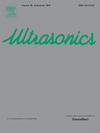Interpolation techniques for ultrasonic data
IF 4.1
2区 物理与天体物理
Q1 ACOUSTICS
引用次数: 0
Abstract
Many applications where ultrasound is used for diagnostics exist where limited data is preventing a particular approach from being fully exploited; for example, sufficient data availability would allow the qualification of non-destructive evaluation (NDE) methods in-silico, and would potentially also enable the training of machine learning algorithms related to ultrasound and its applications. Real, experimental ultrasonic data is often scarce, and while it is already known that finite element (FE) modelling produces data which is sufficiently realistic to augment real data, the computational cost associated with its generation at the scales required for the aforementioned purposes is often prohibitive. In this work, we propose the use of interpolation techniques in combination with results from FE modelling to rapidly generate more data without the need to solve additional FE models. We present the relevant methods to achieve this, and validate them through four exemplary cases of increasing complexity. Validation is achieved through the comparison of interpolation-generated results to those generated by full FE modelling, demonstrating that our method is capable of producing results for different physical setups and signals of various degrees of complexity. The results were typically within less than 1% away from the expected, but generated at a fraction of the typical computational cost, and, while the validation cases examined are of interest to the NDE community, the method extends to other fields where ultrasonic data is of interest.
超声波数据的插值技术
超声波用于诊断的许多应用存在于有限的数据阻止了特定方法的充分利用;例如,足够的数据可用性将允许对非破坏性评估(NDE)方法进行计算机鉴定,并且还可能使与超声及其应用相关的机器学习算法的训练成为可能。真实的实验超声波数据通常是稀缺的,虽然已经知道有限元(FE)建模产生的数据足以增强真实数据,但与上述目的所需的规模相关的计算成本通常是令人望而却步的。在这项工作中,我们建议将插值技术与有限元建模结果结合使用,以快速生成更多数据,而无需求解额外的有限元模型。我们提出了实现这一目标的相关方法,并通过四个日益复杂的示例案例验证了它们。通过将插值生成的结果与完整有限元建模生成的结果进行比较,验证了我们的方法能够为不同的物理设置和不同程度的复杂信号产生结果。结果通常与预期相差不到1%,但产生的计算成本只是典型计算成本的一小部分,而且,虽然NDE社区对验证案例感兴趣,但该方法可以扩展到超声波数据感兴趣的其他领域。
本文章由计算机程序翻译,如有差异,请以英文原文为准。
求助全文
约1分钟内获得全文
求助全文
来源期刊

Ultrasonics
医学-核医学
CiteScore
7.60
自引率
19.00%
发文量
186
审稿时长
3.9 months
期刊介绍:
Ultrasonics is the only internationally established journal which covers the entire field of ultrasound research and technology and all its many applications. Ultrasonics contains a variety of sections to keep readers fully informed and up-to-date on the whole spectrum of research and development throughout the world. Ultrasonics publishes papers of exceptional quality and of relevance to both academia and industry. Manuscripts in which ultrasonics is a central issue and not simply an incidental tool or minor issue, are welcomed.
As well as top quality original research papers and review articles by world renowned experts, Ultrasonics also regularly features short communications, a calendar of forthcoming events and special issues dedicated to topical subjects.
 求助内容:
求助内容: 应助结果提醒方式:
应助结果提醒方式:


